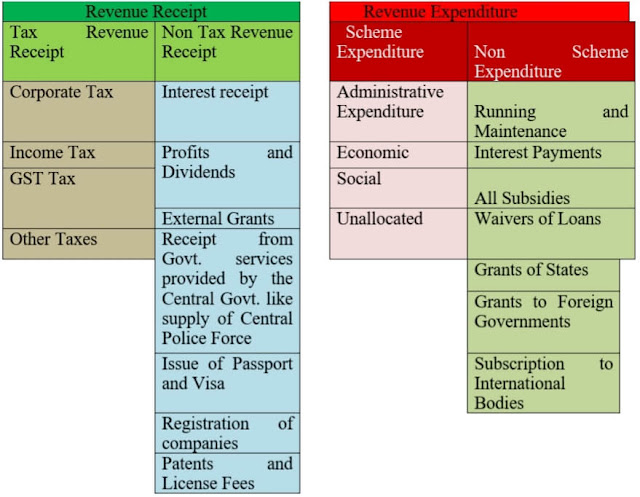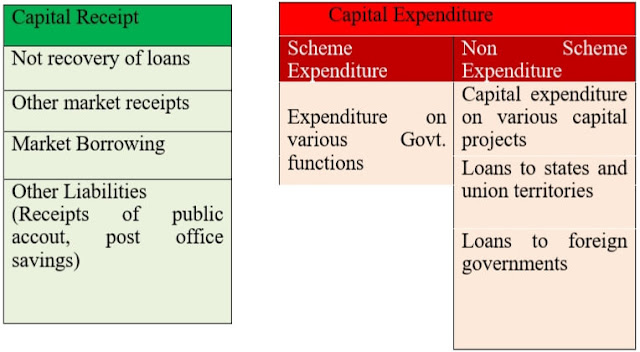Structure and Overview of Indian Budget
Budget Meaning:
The budget is the overall financial
framework that serves as the performance benchmark for all financial decision.
Article 112 of the Constitution of
India calls it – ‘Annual Financial Statement’
·
Statement
of Revenue
·
Statement
of Expenditure
·
Overall
Statement
Importance of Budget:
• Intension of the Government
• Priority of the Government
• Policies of the Government
• Allocation of the Financial
Resources
• Planned approach to
Government’s activities.
• Integrated approach to fiscal
operations
• Influences on the functioning
of the economy
• Index of Government’s
functioning
• Public accountability
Origin of word:
Budget word is adopted from
Middle English Word ‘Bowgett’ which came from Middle French word ‘BOUGETTE’ –
which means a “Leather Bag”.
History of Budget in India:
The founder of
Budget system in India is James Wilson who presented a Budget on 18th Feb.1860
as a member of council of the Viceroy Lord Canning. The First Budget of Independent India was
presented by R. K. Shanmukham Chetty on 26th Nov. 1947.
Who Causes the Budget:
The President of India causes the
budget to be laid before the Lok Sabha.
Department of Ministry of Finance:
The Ministry
comprises of the five Departments namely:
· Department
of Economic Affairs
· Department
of Revenue
· Department
of Expenditure
· Department
of Financial Services
· DIPAM
(Department of Investment and Public Asset Management)
How is the Budget Made in India:
·
The
Budget Division of the Department of Economics Affairs of the Ministry of Finance
is the nodal body responsible for the
preparation & presentation of the Budget.
·
Department
of Economics Affairs of the Ministry of Finance publishes annual Economic
Survey.
·
For
preparing the estimates for the next year, the budget division issues the
circular to –
•
Union Ministries
•
Union Territories
•
Autonomous Bodies & Departments
•
Defence Forces
·
Budget
is made through a consultative process involving –
•
Ministry of Finance
•
NITI Aayog
•
Spending Ministries
Finance
Ministry issues guidelines to spending, based on which ministries present their
demands
Pre-Budget Meetings:
• After receiving the demands, extensive
consultations are held between Union Ministries and Department of Expenditure.
• At the same time pre-budget
consultations are held with different stakeholders viz. State representatives,
Agriculturists, Industrialists, Businessmen, Economists, Civil Society Groups &
Trade Unions to take their views.
• Once the pre-budget meetings are over,
the final call on the tax proposal is taken by the Finance Minister.
• Proposals are discussed with the Prime
minister before the Budget is frozen.
• Finance Ministry collects information
about receipts and expenditure from various departments to prepare the revised estimates
for the budget.
Budget Printing:
• The Finance Minister and other
official participate in ‘Halwa Ceremony’ which marks the starting of the
process of Printing Document of the Budget.
•The officials and support staff
directly involved in the budget making and printing process are required to
stay in the ministry and remain cut-off from their families until the presentation
of the Budget.
Budget Consists of following details:
·
Actual
of the previous year (Actual)
·
Budget
estimate of current year (B.E.)
·
Revised
estimate of current year (R.E.)
·
Proposed
Budget estimate of next year (B.E.)
Presentation of Budget:
• Finance
Minister goes to meet President to seek permission for Budget Presentation.
• The Finance
Minister briefs the cabinet on budget proposals through the ‘summary for the cabinet’
just 10 minutes before presenting the budget in the Parliament.
Budget Consists of two parts:
·
Part
A – Speech
·
Part
B – Amendments in Taxes
Three major changes in budget 2017-18:
·
Budget Presentation Day advanced from
end-February to 1st February.
·
Elimination of the distinction of Plan and
Non-Plan expenditure in the Budget.
·
Railways
Budget merged with General Budget.
Railway Budget briefing:
• 1920 : William
Mitchell Acworth ; Chairman, Committee of East Indian Railways; recommended about consolidation and
nationalization of the Indian Railways.
• Acworth
Committee recommendations were finally passed on 20 September 1924 as the
Separation Convention.
• The Railway
finances of India were separated from the general government finances in 1924.
• Committee of
Restructuring of Indian Railways, Chairman Dr. Bibek Deboray (Sept. 2014 – June
2015); Recommended Railway budget should be phased out, and general budget
support to railways to be mentioned as a paragraphs in the budget.
The budget is divided into two
parts 1- Revenue Account and 2- Capital Account.
Now we will see brief
introduction of above these two accounts…
Revenue Account:
Revenue Account
covers the current receipts and running expenditure. It includes the variations
in money balances created or owned by the Government.
Revenue Receipts include proceeds of taxes and
other duties levied by the Government, interest & dividends on investment
made by the Govt., & Fees and other receipts for services rendered by the
Govt.
Revenue receipts increase treasury’s usable funds
without increasing debt obligations.
Revenue Expenditure is meant for normal
running of Govt. departments and various services, interest charges on debt
incurred by the Govt. and subsidies, grants given by the Govt. etc.
Broadly speaking, the expenditure that does not result in
creation of assets is treated as revenue expenditure. Revenue
expenditure decrease treasury’s usable funds without decreasing debt
obligations.
Capital Account:
The Capital
account covers the creation
and disposal of assets and liabilities. It includes the items of
receipts & disbursements of those items –
·
Which
do not belong to the Govt. (e.g. loans, deposits etc.)
·
Which
lead to variations in physical assets of the Govt. (e.g. their acquisition,
creation, disposal etc.)
·
Which
lead to variations in financial claims & liabilities of the Govt.
The main items
of capital receipts of loans raised by the Govt. from the public, borrowings
from the RBI, loans from abroad, recovery of loans & also proceeds from the
disinvestment of Govt. equity in public enterprises.
Capital Expenditure
includes the payments for acquisition of assets like land, building, machinery,
equipment etc., and also investment in shares & loans given by the Govt.
Revenue Account Chart:-
Capital Account Chart:-
Plan Vs. Non-Plan Expenditure:
·
11th
Finance Commission (2000-2005) headed by Dr. A. M. Khusro had recommended to
examine the issue for eliminating the distinction between plan and non-plan
expenditure.
·
High
level Expert Committee on Efficient Management of Public Expenditure headed by
Dr. C. Rangarajan had recommended a fundamental shift in the approach of public
expenditure by removing the Plan & Non-plan distinction and budgeting
linked to output & outcomes.
·
Union
Budget 2016-17 announced that the Plan & Non-Plan classification to be
eliminated from 2017-18.
·
Now
after abolition of Planning Commission & Setting up of NITI Aayog the term
Plan expenditure has lost its relevance. Therefore after the end of the 12th Five
Year Plan in 2012-17, the Plan and Non plan
distinction has been removed from 2017-18.
Thank You 😊!!!
Note:
- Please give your feedback in the comment box. Your comments mean a lot to us, and can clear your queries.
- You can suggest topics which you need or want to read. We will first try to write the article on the topic suggested by you.
- We need your support so please subscribe the blog and share to at least 5 persons.





Post a Comment
Post a Comment